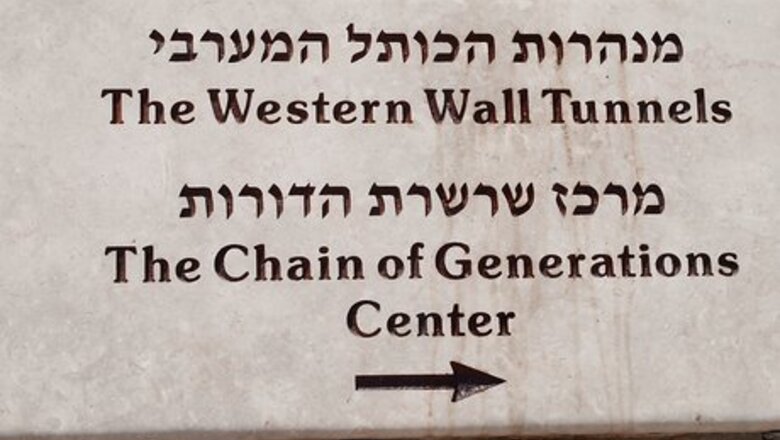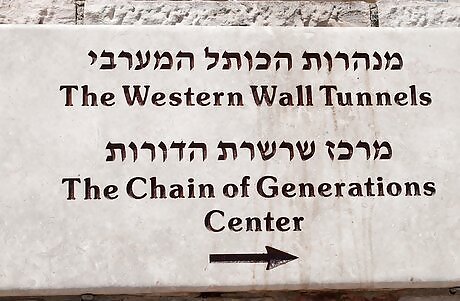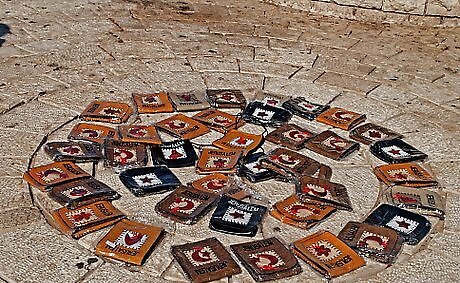
views

Learn the letters, and how to pronounce them. The Hebrew Alphabet has twenty-two letters, and five of them appear different at the end of a word. Keep in mind that none of these letters are possible to pronounce because they are consonants. If you try to pronounce them, it will be like pronouncing consonants of the English alphabet. Here are all of the letters of the Hebrew Alphabet, in order: א Aleph. This is possibly the easiest letter of the alphabet to learn. This is because it has no sound! In order to make it have a sound, one needs to put a vowel with it. It will often be found at the end of a word, making no sound. Think of it like the letter "E" in the English alphabet; it is at the end of a lot of words, but it's silent. Bet(בּ) and Vet(ב). Although these letters seem different because of their two different sounds, they are actually considered the same letter. Bet has a dot, and Vet doesn't. Bet makes the "B" sound, but doesn't actually have a pronunciation until a vowel is added. Vet makes the "V" sound, but needs a vowel to actually be read. ג Gimmel. Because Bet and Vet are essentially the same letter, this is the third letter in the Hebrew Alphabet. It has the "G" sound, like "gate". However, it never has the "G" sound as in "giraffe". Keep this is mind while pronouncing it in a word. Although, a gimmel with a flick or apostrophe (') is a 'giraffe' gimmel. ד Dalet. As it may be easy to guess, Dalet makes the "D" sound. Like all other letters in the Alphabet, it needs a vowel added to have a pronunciation. ה Hey. Hey makes the "H" sound, as in the "H" in "hey". It never makes the "CH" sound as in "chewy", and is often put at the end of a word as an ending, just like how Aleph is added to the end of a word sometimes. ו Vav. Vav makes the same sound as Vet, but is a different letter. ז Zayin. This letter is pronounced just like the "Z" in "crazy". ח Chet. Chet is one of the more well known letters in Hebrew. It sounds almost as if you're hacking on something in your throat, or gargling without water. If those examples still aren't helping you hear the Chet, try growling in the back of your throat. It is a softer version of the noise you get from that. Remember, Chet never makes the "CH" sound as in "chewy". ט Tet. Tet makes the "T" sound as in "tango". It can never make the "TH" sound as in "thicket". י Yod. This letter sounds like the "Y" in "you". Sometimes, it is softened into the sound of "EE", as in "Greek". Most of the time when this letter is in the middle of a word, it is pronounced more like "EE" than "Y". Kaf,(כּ) Chaf(כ), Kaf Sofit(ךּ), and Chaf Sofit(ך). This is one of the more confusing letters. Although it may seem like four different letters, it's all actually the same letter. Chaf is pronounced just like Chet, and Kaf is pronounced like the "C" in "cow". Chaf Sofit is pronounced the same as Chaf, but it comes at the end of a word. Kaf Sofit is pronounced the same as Kaf, but is also only at the end of a word. Although it seems confusing at first, just keep practising. It will all become as clear as your first alphabet after some practise. ל Lamed. Lamed makes the "L" sound, as in "lightning". Mem(מ) and Mem Sofit(ם). Once again, these are actually the same letter, but they have a different version at the end of a word. They make the "M" sound, as in "Mike". Mem Sofit looks like Mem, only it is closed off at the bottom, and looks more boxy. Nun(נ) and Nun Sofit(ן). Nun and Nun Sofit are pronounced like the "N" in "November". You'll only find Nun in the beginning or middle of a letter, and you'll only find Nun Sofit at the end. ס Samech. Samech makes the "S" sound in "sierra". However, it never makes the "SH" sound in "shipwreck". ע Ayin. This is one of the trickier Hebrew letters to pronounce for non-natives, since Latin and Germanic languages do not have this sound. It is pronounced differently in different areas to ease pronunciation. Technically it is a "voiced pharyngeal approximant/fricative," and has equivalents in other Semitic languages, like Arabic and Syriac. In general, non-natives (and even many native Israelis) treat it like an aleph, which is to say, they do not pronounce it, only the vowel underneath it. If you want to try to pronounce the ayin, but can't quite get the voiced pharyngeal approximant/fricative, try pronouncing it like the "ng" in "singing" or the "nk" in "sink." Jews in various parts of the Diaspora pronounce the ayin in this manner. But it is perfectly acceptable to leave it silent. Pey(פ) Fey,(פּ) Fey Sofit(ףּ) and Pey Sofit(ף) Pey is pronounced like the "P" in "papa", and Fey is pronounced like the "F" in "foxtrot". Fey Sofit is a different version with the same pronunciation as Fey, but it comes at the end of a word. Pey Sofit also has the same pronunciation of its other version, but it only comes at the end of a word. Tsadie(צ) and Tsadie Sofit(ץ)(Pronounced Tsadi, very often pronounced Tsadik - as a mistake). Tsadie and Tsadie Sofit are pronounced like the "zz" in "pizza." Tsadie Sofit is the same as Tsadie, but it only comes at the end of a word. It is also pronounced 'tz', and if you put a flick or apostrophe ( ' ) next to it, it's CH, like chocolate. ק Qof. Qof makes the "K" sound, as in "kilo". It can also be pronounced as a "Q" sound, but the "K" sound is more common. ר Resh. This letter makes the "R" sound, as in "roger". Shin(שׁ)and Sin(שׂ). Shin and Sin only have one difference: Sin has a dot over the line furthest to the left, and Shin has a dot over the line furthest to the right. Shin is pronounced "SH", as in "Shucks". Sin makes the "S" sound, like Samech and Tsadie. ת Tav. Tav has the same sound as Tet; like the "T" in "tango".

Learn the vowels. Hebrew vowels are added to consonants to make one sound. For instance, Samech may simply make "S" on its own, if you add a line under it, it becomes "sah". The Hebrew vowels are generally easy to understand with a bit of practice. אֵ Patach. Patach is basically a line to place under any letter, which becomes that letter with the "AH" sound after it, as in "aqua". אָ Kamatz. Kamatz makes the same sound as Patach, and looks almost exactly like it. The only difference is that it has a tiny line in the midsection. וֹ Cholam Malei. Cholam Malei is basically the letter Vav with a dot over it. This creates the "OH" sound, as in "doe". However, this doesn't create the "VO" sound, as the v is lost when the dot is added. בֹּ Cholam Chaser. This vowel can't go over all consonants, which is why there is also Cholam Malei. When this little dot is over (or a little to the left, but still on top) of any consonant, the consonant gains the "OH" sound, in addition to its consonant sound. אֶ Segol. Segol is three dots under a letter that create a triangle shape. These three dots add the "EH" sound as in "echo" to the consonant. For example, adding this to Bet would create the "beh" sound. בֵּ Tzeirei. Tzeirei is two dots under a letter, creating a horizontal line, (not to be confused with sh'va, which creates a vertical line). This adds the "EH" sound to a consonant, just like Segol. For instance, adding this vowel to Vet would create the "veh" sound. מְ Sh'va. Sh'va adds the "UH" sound to a consonant. It also has two dots, but they create a vertical line instead of a horizontal one. Adding this to Mem would make "muh". וּ Shuruk. This vowel creates the "U" sound, as in "blue". It never makes the "UH" sound, which Sh'va does. This vowel can only be added to Vav, which loses its v in the process. אֻ Kubutz. Kubutz is three dots that are horizontal under any consonant, going to the right. It creates the "OO" sound, like "food" or "shoo". Adding this to Bet would make "boo". אֲ Chataf Patach, Chataf Segol, and Chataf Kamatz. Chataf is two dots creating a vertical line, however, it is added to Patach, Segol, or Kamatz to shorten the vowel. Think of it as a sticatto in music, which shortens the note. נִ Chirik. Chirik makes the "ee" sound, as in "Greek" or "me". It is one dot under any consonant. For example, Chirik under Bet creates "bee". רָ Kamatz Katan. This vowel looks like Kamatz, only the second line doesn't actually connect to the midsection. Kamatz Katan creates the "O" sound, like "flow".

Practice reading Hebrew. Learning a new language is never easy, but the more you practice, the easier it will become.

















Comments
0 comment